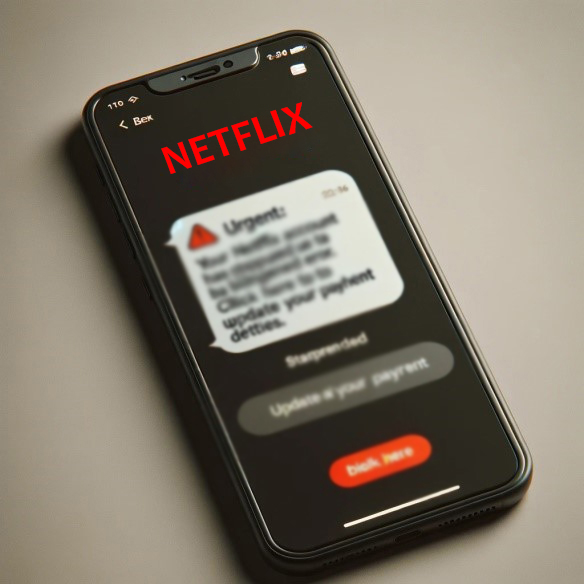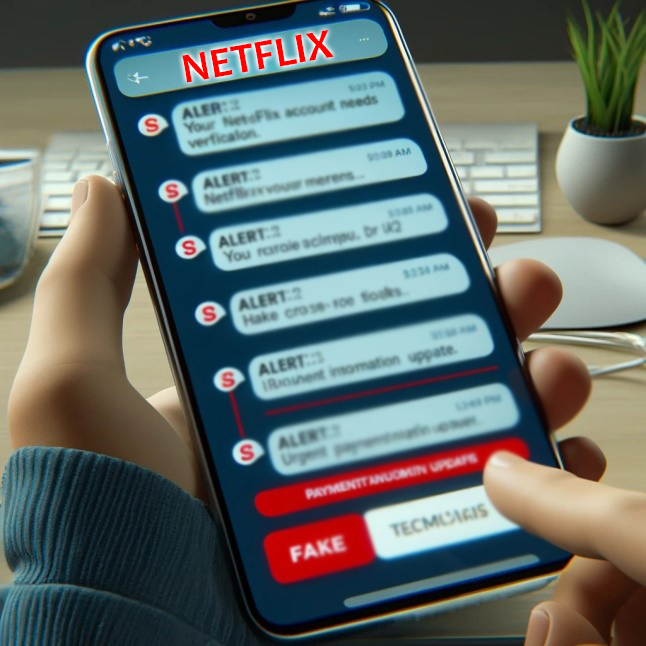Netflix Text Scam
In recent years, digital scams have proliferated across various sectors, with streaming services emerging as a prime target for fraudsters. The evolution of technology and the increasing dependency on digital platforms for entertainment have created fertile ground for scams to thrive. Among these, the Netflix text scam has gained notoriety as a particularly deceptive maneuver designed to exploit unsuspecting subscribers.
The concept of the Netflix scam text involves phishing tactics where victims receive fraudulent messages that appear to be from Netflix. These messages often claim issues with account payments or subscription statuses to create a sense of urgency. By manipulating users into believing their access to Netflix is at risk, scammers cleverly prompt them to click on harmful links or disclose sensitive personal information.
Understanding and recognizing these Netflix scams via text is crucial for the safety of personal and financial information. As these scams become more sophisticated, the importance of staying informed cannot be understated. Awareness and knowledge are powerful tools in the digital age, serving as the first line of defense against the ever-growing wave of phishing SMS Netflix schemes. By educating ourselves and others about the signs and tactics of these scams, we can protect not only our Netflix accounts but also our digital identities.
What is the Netflix Text Scam?
The Netflix text scam has become a prevalent issue for many users, cleverly crafted to deceive and manipulate. This scam involves receiving a Netflix scam text message that ostensibly looks like it’s sent from Netflix itself. Typically, these messages alert the recipient about an urgent issue with their account—be it a problem with the payment method, a pending membership expiration, or an account hold. The ultimate goal of these messages is to lure unsuspecting victims into revealing their private information or financial details.
Common phrases used in these Netflix text message scams include:
- “We’ve encountered a problem with your current billing information.”
- “Your Netflix account will be locked because your payment was declined.”

- “Urgent: Update your payment details to continue enjoying Netflix.”
These messages often create a sense of urgency, pushing the user to act quickly to resolve what appears to be an impending account crisis. They might direct the user to a fraudulent website that mimics the official Netflix login page, tricking them into entering their login information and payment information.
Recent reports from users highlight various incarnations of these scams. For instance, the Netflix on hold text scam informs users that their accounts have been put on hold due to a payment issue and provides a deceptive link to resolve the supposed account problem. Similarly, Netflix scams via text may claim that the user’s subscription is about to expire, with a link to renew it—again leading to a fake website designed to harvest personal data.
Victims of these phishing SMS Netflix scams often find unauthorized transactions, or worse, identity theft, soon after falling prey to these messages. It is crucial to scrutinize any communication from service providers and verify their authenticity through official channels instead of clicking on any links provided in unsolicited texts or emails.
How the Netflix Scam Text Works
The Netflix text scam operates through a series of well-orchestrated steps, designed to extract sensitive information from unsuspecting users. Here’s a detailed breakdown of how victims are commonly targeted in a Netflix phishing attack text.
-
Targeting and Initial Contact:
The scam begins with the victim receiving an unsolicited Netflix scam text. This message usually arrives out of the blue, purporting to be from Netflix, and typically cites some sort of urgent issue requiring immediate attention. The goal here is to catch the recipient off-guard and create a sense of anxiety about their account status.

-
Crafting a Plausible Scenario:
Scammers use plausible scenarios in these Netflix phishing text messages to make their claims more believable. Common narratives include problems with the user’s monthly payment, threats of account suspension, or alerts that the account has been compromised. This step reinforces the scam’s credibility, pushing the user towards taking hasty action.
-
Luring to Fraudulent Websites or Direct Requests:
Victims are directed to click on a link embedded within the Netflix phishing attack text message, leading them to a counterfeit website that mirrors the official Netflix login page. Alternatively, the message might ask the user to reply directly with their personal information, such as credit card numbers or account passwords.
-
Data Harvesting:
Once on the fraudulent website, users are required to enter their login information and update their payment details. Every piece of information entered on these pages is captured by the scammers. In direct request scenarios, any data sent by text is immediately compromised.
-
Exploitation:
With the harvested data, scammers can carry out their ultimate goal: stealing financial information, personal data, or both. This may lead to unauthorized charges, identity theft, or selling information on the dark web.
Psychological Tricks Employed
Scammers leverage powerful psychological tricks to make their scams more effective:
-
Urgency:
By conveying a sense of urgency, scammers pressure the victim to act fast without double-checking the facts. Statements like “immediate action required” or “your account will be suspended” prompt quick reactions.
-
Authority:
The use of Netflix’s brand name exploits the authority bias. Most people trust well-known brands and are less likely to suspect a message apparently coming from such entities.
Understanding the mechanics of a Netflix phishing attack text helps in recognizing and avoiding these scams. Awareness and vigilance are key defenses against falling victim to such Netflix scams via text. Always verify authenticity of suspicious messages through official channels before taking any action.
What to Do If You Fall Victim to a Netflix Text Scam
Realizing that you’ve fallen prey to a Netflix text scam can be distressing, but immediate and strategic actions can help mitigate the damage and prevent further losses. Here is a step-by-step guide on what to do if you find yourself a victim of a Netflix phishing text or any related scam.
Immediate Actions to Take
-
Change Your Netflix Password:
The first step after discovering a Netflix phishing attack text message is to secure your Netflix account. Change password immediately using a strong, unique combination that you haven’t used elsewhere.
-
Secure Related Accounts:
If you used the same password for other accounts, change those as well. Scammers often try multiple accounts with the same credentials.
-
Contact Your Bank:
If you provided any financial information or suspect a netflix payment scam message led to unauthorized transactions, contact your bank or credit card issuer immediately. They can monitor for suspicious activity, reverse any unauthorized transactions, and issue new cards if necessary.
-
Report the Scam:
It’s crucial to report Netflix phishing text incidents not only to Netflix but also to appropriate authorities. Reporting helps alert these organizations about the scam and contributes to preventing future scams. Use official reporting channels provided by Netflix and consider notifying bodies like the FTC in the U.S. or your local consumer protection agencies.
Falling victim to a Netflix scam text is challenging, but taking swift and informed actions can help control the situation and prevent further harm. Always prioritize your digital security and remain cautious about where and how you share your sensitive information.
Preventive Measures to Avoid Netflix Text Scams
Staying vigilant and informed are your best defenses against Netflix text scams. By adopting a set of straightforward preventive measures, you can significantly reduce risk of falling victim to these deceptive practices. Here are some essential tips to help safeguard your personal information and maintain your online security.
Protecting Yourself from Netflix Text Scams
-
Avoid Clicking on Unsolicited Links:
One of the simplest yet most effective ways to avoid Netflix scams via text is to never click on links in unsolicited messages. Even if the message seems to be from Netflix, it’s safer to log into your account directly through the official Netflix app or website to check for any notifications.
-
Verify Via Official Channels:
If you receive a suspicious Netflix scam text that you think might be legitimate, verify its authenticity by contacting Netflix directly through their official customer service channels. This can be done via the customer service section on the Netflix website or through the app.
-
Beware of Alarmist Language:
Many Netflix phishing texts rely on urgent and threatening language to provoke immediate action. Always take a moment to assess the message critically. Netflix will not rush you with deadlines to fix issues via a text message.
Recommended Security Practices for Online Accounts
-
Use Strong Passwords:
Ensure your Netflix account and associated email account are protected with strong, unique passwords. A good password should be a mix of letters, numbers, and special characters, and ideally, be changed regularly.
-
Enable Two-Factor Authentication (2FA):
Adding an extra layer of security through two-factor authentication can significantly secure your online accounts. This makes sure that even if your password is stolen, the chances of unauthorized access to your account are minimized.
-
Regular Account Monitoring:
Keep an eye on account for any unusual activity. Regularly reviewing your account’s access and streaming history can alert you to any unauthorized use.
Reporting Netflix Text Scams
-
Report to Netflix:
If you encounter a Netflix phishing attack text message, it’s important to report it to Netflix. This helps them track scam patterns and potentially warn other users. Netflix provides a specific protocol for reporting phishing attempts which can be accessed through their official site.
-
Educate Others:
Share your knowledge and experience about Netflix scams via text with friends and family. Educating others is a powerful tool in preventing scams and strengthening collective security online.
By adopting these preventive measures, you can better protect yourself from falling prey to Netflix text scams. Always stay informed, skeptical, and proactive about your digital security to fend off potential scammers effectively.
FAQs
Q1. What is a Netflix text scam?
- A. A Netflix text scam involves receiving fraudulent messages that appear to be from Netflix, typically asking for personal information or payment details due to a supposed issue with your account.
Q2. How can I recognize a Netflix scam text message?
- A. Look out for urgent language, requests for personal information, unsolicited links, and poor grammar—these are common indicators of a Netflix scam text message.
Q3. What should I do if I receive a Netflix phishing text?
- A. Do not click on any links. Verify the message by directly logging into your Netflix account through the official website or app, and report Netflix phishing text to Netflix’s official customer support.
Q4. What are common signs of a Netflix phishing attack text?
- A. Common signs include unexpected requests to update your payment details, alerts about your account being on hold, or links to update your account information—all typical of a Netflix phishing attack text.
Q5. How does a Netflix phishing attack text message work?
- A. A Netflix phishing attack text message tricks you into clicking link that leads to a fake website where scammers collect your personal and financial information.
Q6. What is the difference between a Netflix on hold text scam and other Netflix scams?
- A. A Netflix on hold text scam specifically warns that your account has been suspended and will often ask you to click a link to restore it, unlike other scams that may just ask for payment updates.
Q7. Can a Netflix payment scam message result in financial theft?
- A. Yes, a Netflix payment scam message can lead to unauthorized transactions if you provide your payment details, which scammers can use to access your financial accounts.
Q8. How can I report Netflix scams via text?
- A. You should report Netflix scams via text to Netflix through their official help center and also inform your local authorities or cybersecurity agencies.
Q9. Are there specific steps to safely handle a Netflix text message scam?
- A. If you suspect a Netflix text message scam, do not respond to the message. Instead, log into your Netflix account through a secure connection to check for any official notifications and report the incident.
Q10. What makes phishing SMS Netflix different from email phishing?
- A. Phishing SMS Netflix scams are targeted text messages sent to your phone that pretend to be from Netflix, often more immediate and personal than email phishing, which can target a broader audience. If you still receive such phishing emails and want to stop them immediately, you can read our detailed blog on the Netflix Scam Email.
Conclusion
Throughout this discussion on the Netflix text scam, we have delved into various aspects of these deceptive tactics, from understanding what these scams entail to recognizing the warning signs and knowing how to react if targeted. The prevalence of Netflix scams via text is a reminder of the increasingly sophisticated methods scammers use to exploit digital platforms where consumers frequently engage.
Netflix scam text messages and phishing SMS Netflix not only compromise personal security but can also lead to significant financial loss. Hence, it is vital to stay vigilant and informed about the latest scamming techniques. By educating yourself and others, you contribute to a safer digital environment for everyone. Knowledge is power in battle against cyber threats, and understanding the mechanics of scams enhances your ability to spot and avoid them.
Let this guide serve as a call to action: share this information widely with friends, family, and colleagues. The more people are aware of how to identify a Netflix scam text, the less likely they are to fall victim to these frauds. Spread the word on social media, in personal conversations, and through community forums. Each informed individual adds to the network of defense against these digital predators.
Together, by staying alert and informed, we can significantly reduce the impact of Netflix scams via text and other similar phishing attempts. Let’s commit to maintaining our vigilance and continuously educating ourselves and our communities to navigate the digital world securely and confidently. For more information about the Netflix text scam and to resolve related issues, please visit our Netflix Support page.


William wilson
I received a text message claiming there’s an issue with my Netflix billing information and it urgently needs updating. How can I confirm if this is a legitimate notification or a Netflix scam text message?
Support Admin
To determine whether a text message regarding your billing information is legitimate or a Netflix scam text message, the first step is to critically evaluate the content of the message. Look for urgent language, such as warnings that your account will be suspended if you don’t act immediately. Remember, legitimate Netflix communications will not pressure you to make hasty decisions. Instead of clicking any links in the message, go directly to the official Netflix website or app, and log in to your account to check for any billing issues or notifications. This ensures that you are viewing genuine information directly from Netflix and not through a potentially fraudulent link.